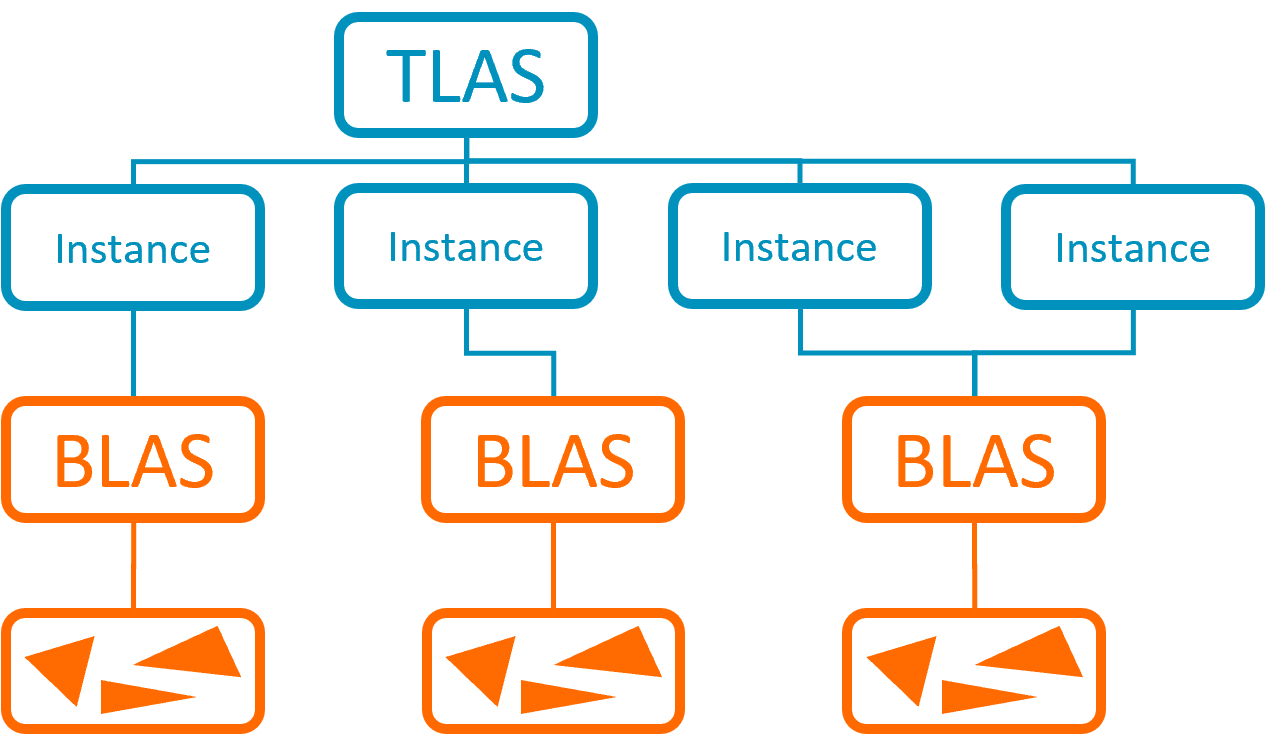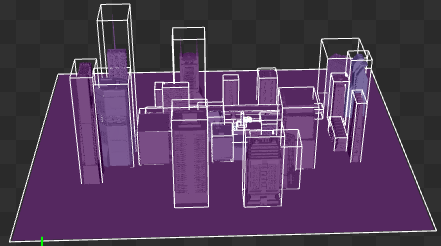Acceleration structure
For ray tracing, the first thing that you need is to create an acceleration structure to represent a scene.
An acceleration structure is an optimized data structure for fast ray intersection tests. It organizes the geometry so that you can efficiently narrow down what each ray intersects. Vulkan represents them using VK_KHR_acceleration_structure, and although the actual structure is opaque and defined by the implementation, it is usually implemented as a tree-like structure, and the API gives some options to control the topology and keep it balanced.
The API makes a distinction between Bottom-Level Acceleration Structures (BLAS) and Top-Level Accelerations Structures (TLAS).
Bottom-Level Acceleration Structures contain the actual geometry data, usually as triangles, but they can also be mathematically-defined models. The actual implementation of a BLAS is opaque to users, but the driver usually organizes this data in a Bounding Volume Hierarchy (BVH), so that when you cast a ray, you can minimize the number of triangle intersection checks.
Top-Level Accelerations Structures contain Bottom-Level Acceleration Structures. Top-Level Acceleration Structures use instances to group BLASes and link them with other properties. These properties include a custom ID, which you can use to define a material; or a transform matrix, which you can use to efficiently update animations.
 Scheme of an Acceleration structure
Scheme of an Acceleration structure
Acceleration structure best practice
As building BLASes and TLASes is relatively expensive, it is best to try to reduce the number of acceleration structures builds and updates.
Skinned animations are costly in ray tracing as they require you to continuously update the BLASes of the meshes. It is recommended that you limit the number of skinned objects in your scenes. Depending on your use case, you might consider not updating all the acceleration structures in every frame. It is usually possible to reuse the same old acceleration structure across a few frames, without noticeable artifacts. Similarly, you can implement some kind of heuristic to reduce the update frequency of objects too far from the camera, although this can be tricky since most effects still need to consider objects outside the view frustum.
When building a new BLAS, it is generally recommended to use VK_BUILD_ACCELERATION_STRUCTURE_PREFER_FAST_TRACE_BIT_KHR for static geometry. VK_BUILD_ACCELERATION_STRUCTURE_PREFER_FAST_BUILD_BIT_KHR can be faster in certain situations, such as dynamic geometry or streaming. If updating BLASes becomes problematic, you can consider testing alternative options.
When building new TLASes, it is recommended to use PREFER_FAST_BUILD. For TLASes, PREFER_FAST_TRACE can be useful for a static scene without updates; however, the build itself is more expensive. In general, BLASes are in use for a long time, but TLASes are only in use for a few frames. This means that it is usually not efficient to build your TLAS with PREFER_FAST_TRACE.
Similarly, building a new acceleration structure is significantly slower than updating or refitting an existing one. Try to avoid creating new acceleration structures from scratch, and if possible, set the srcAccelerationStructure field. Setting a previous version of the acceleration structure as a base for the new acceleration structure will be significantly faster since it triggers an update or refit instead of a build. Remember to also set VK_BUILD_ACCELERATION_STRUCTURE_ALLOW_UPDATE_BIT_KHR when creating the acceleration structure.
In
ray tracing best practices
it is recommended that you use PREFER_FAST_TRACE for static BLASes. For TLASes and dynamic BLASes PREFER_FAST_BUILD is recommended, usually in combination with ALLOW_UPDATE.
void create_blas(bool allow_update, std::vector<VkAccelerationStructureGeometryKHR> &&geometries, std::vector<uint32_t> &&geometry_primitive_counts, VkAccelerationStructureKHR prev_as = VK_NULL_HANDLE)
{
VkAccelerationStructureBuildGeometryInfoKHR blas_geom_info{};
blas_geom_info.sType = VK_STRUCTURE_TYPE_ACCELERATION_STRUCTURE_BUILD_GEOMETRY_INFO_KHR;
blas_geom_info.type = VK_ACCELERATION_STRUCTURE_TYPE_BOTTOM_LEVEL_KHR;
if (prev_as != VK_NULL_HANDLE)
{
blas_geom_info.mode = VK_BUILD_ACCELERATION_STRUCTURE_MODE_UPDATE_KHR;
blas_geom_info.srcAccelerationStructure = prev_as;
}
else
{
// No previous Acceleration structure. Creating a new AS
blas_geom_info.mode = VK_BUILD_ACCELERATION_STRUCTURE_MODE_BUILD_KHR;
}
// BLASes almost never change. Prefer fast trace, it is generally faster for BLAS
blas_geom_info.flags = VK_BUILD_ACCELERATION_STRUCTURE_PREFER_FAST_TRACE_BIT_KHR;
if (allow_update)
{
// Probably skinned mesh
blas_geom_info.flags |= VK_BUILD_ACCELERATION_STRUCTURE_ALLOW_UPDATE_BIT_KHR;
}
build_as(blas_geom_info, geometries, geometry_primitive_counts);
}
void create_tlas(bool allow_update, std::vector<VkAccelerationStructureGeometryKHR> &&geometries, std::vector<uint32_t> &&geometry_primitive_counts, VkAccelerationStructureKHR prev_as = VK_NULL_HANDLE)
{
VkAccelerationStructureBuildGeometryInfoKHR tlas_geom_info{};
tlas_geom_info.sType = VK_STRUCTURE_TYPE_ACCELERATION_STRUCTURE_BUILD_GEOMETRY_INFO_KHR;
tlas_geom_info.type = VK_ACCELERATION_STRUCTURE_TYPE_TOP_LEVEL_KHR;
if (prev_as != VK_NULL_HANDLE)
{
tlas_geom_info.mode = VK_BUILD_ACCELERATION_STRUCTURE_MODE_UPDATE_KHR;
tlas_geom_info.srcAccelerationStructure = prev_as;
}
else
{
// No previous Acceleration Structure. Creating a new AS
tlas_geom_info.mode = VK_BUILD_ACCELERATION_STRUCTURE_MODE_BUILD_KHR;
}
// TLASes can change each frame. Prefer fast build is generally faster for TLAS
tlas_geom_info.flags = VK_BUILD_ACCELERATION_STRUCTURE_PREFER_FAST_BUILD_BIT_KHR;
if (allow_update)
{
// Updating a TLAS is faster than creating a new one from scratch.
tlas_geom_info.flags |= VK_BUILD_ACCELERATION_STRUCTURE_ALLOW_UPDATE_BIT_KHR;
}
build_as(tlas_geom_info, geometries, geometry_primitive_counts);
}
void build_as(VkAccelerationStructureBuildGeometryInfoKHR as_geom_info, std::vector<VkAccelerationStructureGeometryKHR> &&geometries, std::vector<uint32_t> &&geometry_primitive_counts)
{
bool build_on_host = false;
assert(geometries.size() == geometry_primitive_counts.size())
as_geom_info.geometryCount = to_u32(geometries.size());
as_geom_info.pGeometries = geometries.data();
// Query size
as_geom_info.dstAccelerationStructure = VK_NULL_HANDLE;
as_geom_info.scratchData = {};
VkAccelerationStructureBuildSizesInfoKHR build_sizes{};
build_sizes.sType = VK_STRUCTURE_TYPE_ACCELERATION_STRUCTURE_BUILD_SIZES_INFO_KHR;
vkGetAccelerationStructureBuildSizesKHR(device,
build_on_host ? VK_ACCELERATION_STRUCTURE_BUILD_TYPE_HOST_KHR : VK_ACCELERATION_STRUCTURE_BUILD_TYPE_DEVICE_KHR,
&as_geom_info,
geometry_primitive_counts.data(),
&build_sizes);
auto buffer = create_buffer(device,
build_sizes.accelerationStructureSize, // PREFER_FAST_BUILD can reduce this size
VK_BUFFER_USAGE_ACCELERATION_STRUCTURE_STORAGE_BIT_KHR);
VkAccelerationStructureTypeKHR as_handle{VK_NULL_HANDLE};
VkAccelerationStructureCreateInfoKHR create_info{};
create_info.sType = VK_STRUCTURE_TYPE_ACCELERATION_STRUCTURE_CREATE_INFO_KHR;
create_info.type = tlas_geom_info.type;
create_info.buffer = buffer.get_handle();
create_info.offset = buffer.get_offset(); // ensure buffer device address is aligned
create_info.size = buffer.get_size(); // build_sizes.accelerationStructureSize;
vkCreateAccelerationStructureKHR(device, &create_info, nullptr, &as_handle);
// Create scratch buffer
VkDeviceSize scratch_size = as_geom_info != VK_NULL_HANDLE ? build_sizes.updateScratchSize : build_sizes.buildScratchSize;
auto scratch_buffer = create_buffer(device, scratch_size, VK_BUFFER_USAGE_STORAGE_BUFFER_BIT);
if (build_on_host)
{
as_geom_info.scratchData.hostAddress = scratch_buffer.get_mapped_data();
}
else
{
VkBufferDeviceAddressInfoKHR buffer_device_address_info{VK_STRUCTURE_TYPE_BUFFER_DEVICE_ADDRESS_INFO};
buffer_device_address_info.pNext = nullptr;
buffer_device_address_info.buffer = scratch_buffer.get_handle();
as_geom_info.scratchData.deviceAddress = vkGetBufferDeviceAddressKHR(device, &buffer_device_address_info);
}
as_geom_info.scratchData += scratch_buffer.get_offset(); // ensure it is aligned
as_geom_info.dstAccelerationStructure = as_handle;
std::vector<VkAccelerationStructureBuildRangeInfoKHR> build_range_infos{};
build_range_infos.reserve(geometry_primitive_counts.size());
for (uint32_t geom_primitive_count : geometry_primitive_counts)
{
VkAccelerationStructureBuildRangeInfoKHR geom_range_info{};
geom_range_info.primitiveCount = geom_primitive_count;
build_range_infos.emplace_back(geom_range_info);
}
if (build_on_host)
{
vkBuildAccelerationStructuresKHR(device, VK_NULL_HANDLE, 1, &as_geom_info, &build_range_infos.data());
}
else
{
vkCmdBuildAccelerationStructuresKHR(command_buffer, 1, &as_geom_info, &build_range_infos.data());
}
}
Finally, the quality of your geometry can have a huge impact when building your acceleration structure. Try to reduce the number of vertices as much as possible. Grouping objects close together into the same BLAS can also have a positive impact. At the same time, try to reduce overlapping across BLASes and reduce empty space inside a BLAS as much as possible. Empty space will increase the size of a BLAS, which might cause extra AABB hits. Similarly, if BLASes overlap, you might need to evaluate triangles on multiples BLASes.
 Example of a scene with a bad acceleration structure: Significant overlap and empty space. This will result in unnecessary triangle intersections.
Example of a scene with a bad acceleration structure: Significant overlap and empty space. This will result in unnecessary triangle intersections. Example of a scene with a good acceleration structure: Minimum overlap and empty space.
Example of a scene with a good acceleration structure: Minimum overlap and empty space.When tracing a scene, it is common to have opaque and non-opaque objects. Non-opaque objects will invoke the Any-Hit shader and require extra evaluation in ray query. Vulkan allows you to use the flags VK_GEOMETRY_INSTANCE_FORCE_OPAQUE_BIT_KHR and VK_GEOMETRY_OPAQUE_BIT_KHR to mark specific instances and geometries as opaque. It is recommended that you use the appropriate flags to mark relevant geometry as opaque.
Vulkan also offers shader flags. These affect all objects, but they offer better performance. You can use gl_RayFlagsCullNoOpaqueEXT to cull non-opaque geometries or gl_RayFlagsOpaqueEXT, to mark all objects as opaque. To enable compiler optimizations, you should also use gl_RayFlagsSkipAABBEXT and ensure the flags can be resolved statically. If possible, as a preference, use gl_RayFlagsCullNoOpaqueEXT as it might improve shader performance.
// [GOOD] Compiler optimizations enabled
const uint ray_flags_1 = gl_RayFlagsSkipAABBEXT | gl_RayFlagsCullNoOpaqueEXT;
// [BAD] Compiler optimizations might not be enabled on older GPUs
const uint ray_flags_2 = gl_RayFlagsSkipAABBEXT | gl_RayFlagsOpaqueEXT;
// [BAD] Compiler optimizations not enabled, SkipAABB is needed
const uint ray_flags_3 = gl_RayFlagsCullNoOpaqueEXT;
// [GOOD] Compiler optimizations are still enabled, better case for shadows
const uint ray_flags_4 = gl_RayFlagsSkipAABBEXT | gl_RayFlagsCullNoOpaqueEXT | gl_RayFlagsTerminateOnFirstHitEXT;
// [BAD] Error, flags are incompatible
const uint ray_flags_5 = gl_RayFlagsOpaqueEXT | gl_RayFlagsCullNoOpaqueEXT;
// [BAD] Compiler optimizations are only enabled if the flags can be resolved statically at shader compilation time
const uint ray_flags_6 = get_condition() ? gl_RayFlagsSkipAABBEXT | gl_RayFlagsCullNoOpaqueEXT : gl_RayFlagsSkipAABBEXT;